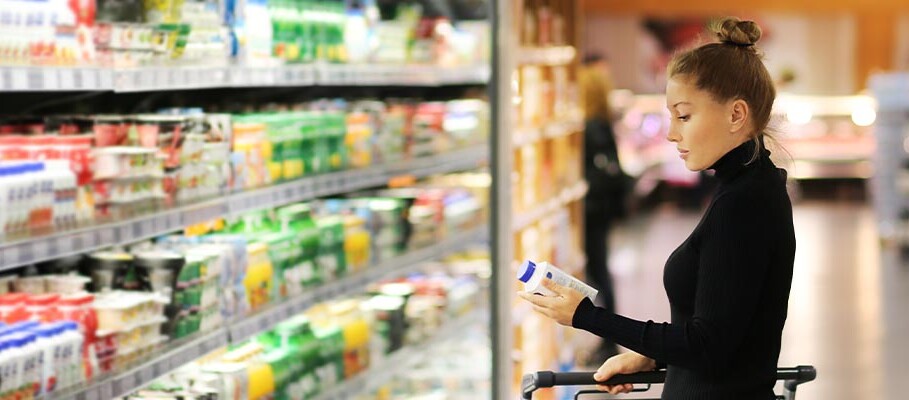Table of Content
- The Impact of Industrial Lighting on Perishable Appearance and Shelf Life
- Choosing the Right Technology: LEDs vs. Conventional Supermarket Lighting
- The Science of Color: CRI and Its Importance in Supermarkets
- Cost Savings with efficient Supermarket Lighting
- Supermarket Lighting Design: Strategies for Maximum Impact
- Installation and Maintenance of Supermarket Lighting Systems
- Pro Tip: Use Smart Controls for your Supermarket Lighting
- Conclusion
1. The Impact of Industrial Lighting on Perishable Appearance and Shelf Life
The appearance of fresh produce is extremely important. Shoppers often decide what to buy based on how the food item looks. Bright colors, appealing textures, and a fresh look make a big difference. Supermarket lighting does more than just brighten a space; it shapes how fresh produce looks and attracts customers.
But the wrong lighting can make even top-quality produce seem dull, unappetizing, or even spoiled.
Think about red peppers under a warm, yellowish light versus a bright, white light. The white light makes them look fresher and more vibrant. The way produce looks directly influences sales. Studies show that well-lit produce displays encourage more impulse purchases.
Lighting also affects shelf life. Older industrial lighting like fluorescent and incandescent bulbs give off a lot of ultraviolet (UV) and infrared (IR) radiation. UV light can cause discoloration, loss of nutrients, and damage to the produce. IR light creates heat, which speeds up wilting, dehydration, and spoilage. This leads to more waste and lower profits.
The challenge is to find supermarket lighting that makes produce look great while preventing these problems. Can modern ceiling lights solve this issue?
For more information on this subject, you can refer to this insightful study published in the European Journal of Marketing: (PDF) Impact of store environment on impulse buying behavior
2. Choosing the Right Technology: LEDs vs. Conventional Supermarket Lighting
The lighting industry has changed a lot recently, with LEDs becoming the go-to choice for many uses, including supermarket lighting.
It’s important to understand the differences between LEDs and older types of lighting like fluorescent and incandescent bulbs to make the best decisions.
- Incandescent Lighting: These are the oldest type of light bulbs and not very energy-efficient. They give off a warm, yellowish light and don’t show colors as well. They also produce more heat, which isn’t ideal for lighting fresh produce. Since they don’t last long and use more energy, they are less commonly used in modern supermarkets.
- Fluorescent Lighting: Fluorescent lights are more energy-efficient than incandescent bulbs and were used a lot in supermarkets for many years. However, they don’t show colors as accurately as LEDs, and they contain small amounts of mercury, which needs careful disposal. Sometimes, they can flicker, causing discomfort for customers and staff.
- LED Ceiling Lights: LEDs have many benefits for supermarket lighting. They use less energy, turn more electricity into light, and produce less heat, which helps lower energy costs and protects perishable items. LEDs also last much longer than older bulbs, cutting down on maintenance and replacement costs. Plus, they give off little UV or IR radiation, helping keep produce fresher for longer. LEDs come in different colors and can be adjusted to create the best lighting. Flush ceiling lights and pendant lights are also options, mainly for design.

3. The Science of Color: CRI and Its Importance in Supermarkets
The Color Rendering Index (CRI) is an important measure for how well a light shows the true colors of objects, which is especially important in places like supermarkets. CRI tells us how closely a light source matches natural light (like sunlight) when showing colors. It’s scored from 0 to 100, with 100 meaning perfect color accuracy.
Lights with a low CRI can make colors look dull, faded, or unnatural. This is a problem for displays of fresh produce and meat, where bright, natural colors are important to attract customers. For example, a light with a low CRI might make red meat look brown or green vegetables look yellowish.
Supermarket lighting should have a CRI of at least 80, and many high-quality LEDs have a CRI above 90. This ensures that the colors of products are shown accurately, making them look more appealing and tempting to shoppers.
The difference between lighting with a low CRI and a high CRI can be huge and can affect whether customers decide to buy something. How can businesses measure how CRI affects sales?
4. Cost Savings with efficient Supermarket Lighting
Upgrading to energy-efficient industrial lighting, like LED ceiling lights, in a supermarket can be a significant investment, but it often provides quick and clear returns. The financial benefits extend beyond just lowering energy costs.
- Lower Energy Use: LEDs consume much less energy than older lighting options, often using 50-80% less electricity to produce the same amount of light. This results in lower monthly energy bills, which can be a substantial saving for large supermarkets with extensive lighting needs.
- Lower Maintenance Costs: LEDs have an impressive lifespan, often lasting over 50,000 hours. This reduces the frequency of bulb replacements, lowering labor costs and minimizing disruptions to store operations.
- Less Waste and Spoilage: As noted earlier, LEDs emit less heat and harmful radiation, helping keep perishable goods fresh for longer. This reduces waste and spoilage, saving money on disposal costs and boosting sustainability.
- Higher Sales and Customer Satisfaction: Better lighting improves the appearance of products, which can increase sales. A well-lit and inviting environment also creates a more positive shopping experience, encouraging customer loyalty.
Are you looking for a professional who offers LED light installations? Request a quote on our website to find the ideal supplier.

5. Supermarket Lighting Design: Strategies for Maximum Impact
Effective supermarket lighting design is more than just choosing the right technology; it's about using light to create a certain atmosphere and influence customer behavior.
A well-planned lighting setup takes several important factors into account:
- Ambient Lighting: This is the general lighting that lights up the entire store. It should provide a comfortable level of light, making it easy for customers to move around. Ceiling lights, such as LED panels or troffers, are often used for this purpose.
- Accent Lighting: This type of lighting highlights certain product displays, drawing attention to areas like produce, meat, seafood, and special promotions. Spotlights, track lighting, and display case lighting are common for accent lighting. The goal is to create contrast and make these displays stand out to encourage customers to buy.
- Task Lighting: This provides focused light for specific tasks, such as at checkout counters or food prep areas. It ensures that employees have enough light to work safely and efficiently.
- Color Temperature: The color temperature of light, measured in Kelvin (K), affects how warm or cool the light feels. Warmer light (lower Kelvin) creates a cozy atmosphere, while cooler light (higher Kelvin) feels brighter and more energetic. Different areas of the store may need different color temperatures. For example, warmer light may be used in the bakery to make baked goods look more inviting, while cooler light can be used in the produce section to make fruits and vegetables appear fresher.
- Layering: Great lighting design often combines different types of lighting to create a dynamic environment. Mixing ambient, accent, and task lighting adds depth and visual interest, guiding customers' eyes and highlighting important areas.
6. Installation and Maintenance of Supermarket Lighting Systems
Proper installation and regular maintenance are essential to ensure a supermarket lighting system works well for the long term.
- Professional Installation: It’s a good idea to hire an experienced electrical contractor who specializes in industrial lighting installations. They can make sure the system is set up safely, correctly, and in line with all necessary electrical codes. Poor installation can cause safety risks, reduce the lighting system’s effectiveness, and even lead to early failure.
- Regular Cleaning: Dust and dirt can build up on light fixtures, reducing how much light they produce and lowering their efficiency. Cleaning the fixtures regularly, according to the manufacturer’s guidelines, helps keep everything running at its best.
- Scheduled Maintenance: Even though LEDs last a long time, it’s still important to have periodic checks and maintenance. This can include checking for loose connections, damaged fixtures, and making sure all parts are working properly.
- Compliance: Supermarket lighting needs to follow various safety and energy rules. These regulations can differ depending on the location, so it’s important to know and follow the correct codes. Working with a qualified contractor can help ensure everything stays compliant.
Are you a lighting supplier looking for more exposure? Our team can help you to reach new customers. Request a consultation to learn more.

7. Pro Tip: Use Smart Controls for your Supermarket Lighting
Don't just replace your old lights; upgrade to a system with smart controls. Modern supermarket lighting, especially with LEDs, can be connected to systems that let you dim lights automatically based on daylight or time of day, control different areas of the store separately, and even track energy use.
This lets you fine-tune your lighting for maximum energy savings and the best possible display of your products, all while gathering data to make even better decisions in the future. This level of control provides important cost optimization.
8. Conclusion
Effective supermarket lighting, especially with LED ceiling lights, is more than just providing light. It’s a powerful tool that improves the look of fresh produce, helps extend shelf life by reducing harmful radiation, and boosts sales by improving product display.
High CRI (accurate color rendering) is essential, and a well-designed lighting plan, using various types of lighting, creates a welcoming environment. Smart controls can further optimize lighting, saving energy and offering valuable insights. Together, these factors can lead to a significant increase in return on investment (ROI).
But there is even greater potential for the future. Lighting can go beyond just smart controls to actively respond to the produce itself.
Sensors integrated into industrial lighting could analyze the ripeness of fruits and vegetables in real time. This data could adjust the lighting to highlight each item’s best appearance and even alert staff when it’s time to restock.
As a result, responsive lighting, which combines lighting with advanced sensors and data analysis, could completely change how supermarkets manage freshness and reduce waste, improving operational efficiency.
For more information on supermarkets and the food industry, read these insightful articles:
- Supermarket Lighting: Improve Sales & Customer Experience
- Glass Food Storage Containers for supermarkets
- Supermarket Shelves: A Guide to Maximizing Space
- Edible Food Packaging: A Sustainable Future?
- Fermented Foods: Benefits, Trends & Sustainability
- Stainless Steel in Food Processing: Highest Hygiene
- Vegan Sweets: A Growing Market for Bakeries
- Gluten-Free Sweets: A Growing Market for B2B Bakeries
Find Lighting Solutions for Your Project!
SIPRIX: The company specializes in professional electrical installations for commercial spaces, providing energy-efficient lighting solutions and reliable power distribution, including LED panel installation and comprehensive distribution board setup. Their services ensure optimal lighting performance, safety, and compliance, maximizing both operational efficiency and cost savings for businesses like supermarkets.
Radium Lampenwerk GmbH: Germany's oldest active lamp manufacturer, offers high-quality lighting solutions, blending traditional lamp expertise with innovative LED technology to meet the evolving needs of specialist retailers, international clients, and industrial applications. With over a century of experience, Radium provides both high-volume production and specialized custom lamps, ensuring excellent quality and customer service for diverse lighting requirements.
Struck – Leuchten GmbH & Co. KG: Is a leading German manufacturer of high-quality illuminated advertising systems, serving a diverse clientele across Europe, including major breweries, insurance companies, and renowned brands. They offer comprehensive in-house production, from design and manufacturing to installation and maintenance, providing clients with customized branding solutions and complete project management, ensuring a distinctive and impactful brand presence.
LB-electronics GmbH: Founded in 1981, is a market-leading distributor of high-quality broadcast technologies, offering a comprehensive range of products and specialized system solutions, including studio planning, lighting technology, and mobile transmission. The company's expertise extends to providing tailored services and support, solidifying its position within the LB Group as a key provider of innovative broadcast solutions.
Jung-Leuchten: A family-owned business for over 65 years, specializes in developing and manufacturing high-quality, durable technical lighting, including explosion-proof LED lights certified for hazardous environments (ATEX zones 1, 21, 2, and 22). They offer a wide range of customizable lighting solutions—in steel, stainless steel, or aluminum, with various finishes, mounting options, and protection classes—for diverse applications, from industrial workspaces and cleanrooms to specialized cabins and surface control.
HEMAPLAST: A family-owned company with over 40 years of experience, specializes in the development, production, and maintenance of skylights, roof light strips, and natural smoke and heat extraction systems (RWA/NRA). They are known for their high-quality, durable products, reliability, and service, providing both standard and customized solutions for new construction and roof renovation projects.
Lichttechnik Hessling: A leading electrical service specialist for nearly 50 years, provides comprehensive lighting solutions, including television-ready floodlight systems for stadiums and arenas, and architectural lighting for buildings. Offering a full range of services from planning and installation to maintenance, Hessling, along with its subsidiaries specializing in lightning protection and network construction, delivers complete project management from a single source.
Delychi GmbH: Offers resource-efficient manufacturing, production monitoring, and freight logistics services, specializing in high-quality LED lighting solutions for various applications. Their product range includes energy-saving linear lighting systems, versatile recessed lights, track systems, advertising modules, controllers, and LED tubes.
BLLS LEDLighting: This company offers exceptionally competitive pricing on a wide range of lamps and lighting systems, including LED bulbs, tubes, strip lights, spotlights, panels, and floodlights. Their direct-from-Asia manufacturing, without intermediaries, allows for significantly lower prices than competitors.
Eco Green Plus: An Italian company founded in 2022, offers comprehensive energy efficiency and sustainability solutions for businesses and individuals. Their services include energy supply, photovoltaic system design and installation, LED relamping, electric vehicle charging, HVAC systems, industrial solutions, and sustainability reporting, promoting cost reduction and a transition to clean energy.
M-Tech: This electrical installation company, with a team of over 100 experienced professionals, specializes in high-quality, precise electrical work for residential, commercial, and industrial projects. Their services include smart home installations, information systems, complex electrical connections, and lighting system installation and repair, with a commitment to modern methods and ongoing training to meet evolving industry demands.
Capital City Electrical: NICEIC-approved electrical contractors, offers a wide range of electrical services, including lighting design and installation, for both residential and commercial clients in Edinburgh, Scotland, and Northern England. They also provide wiring, emergency services, electrical testing, and OLEV-accredited EV charger installations.

